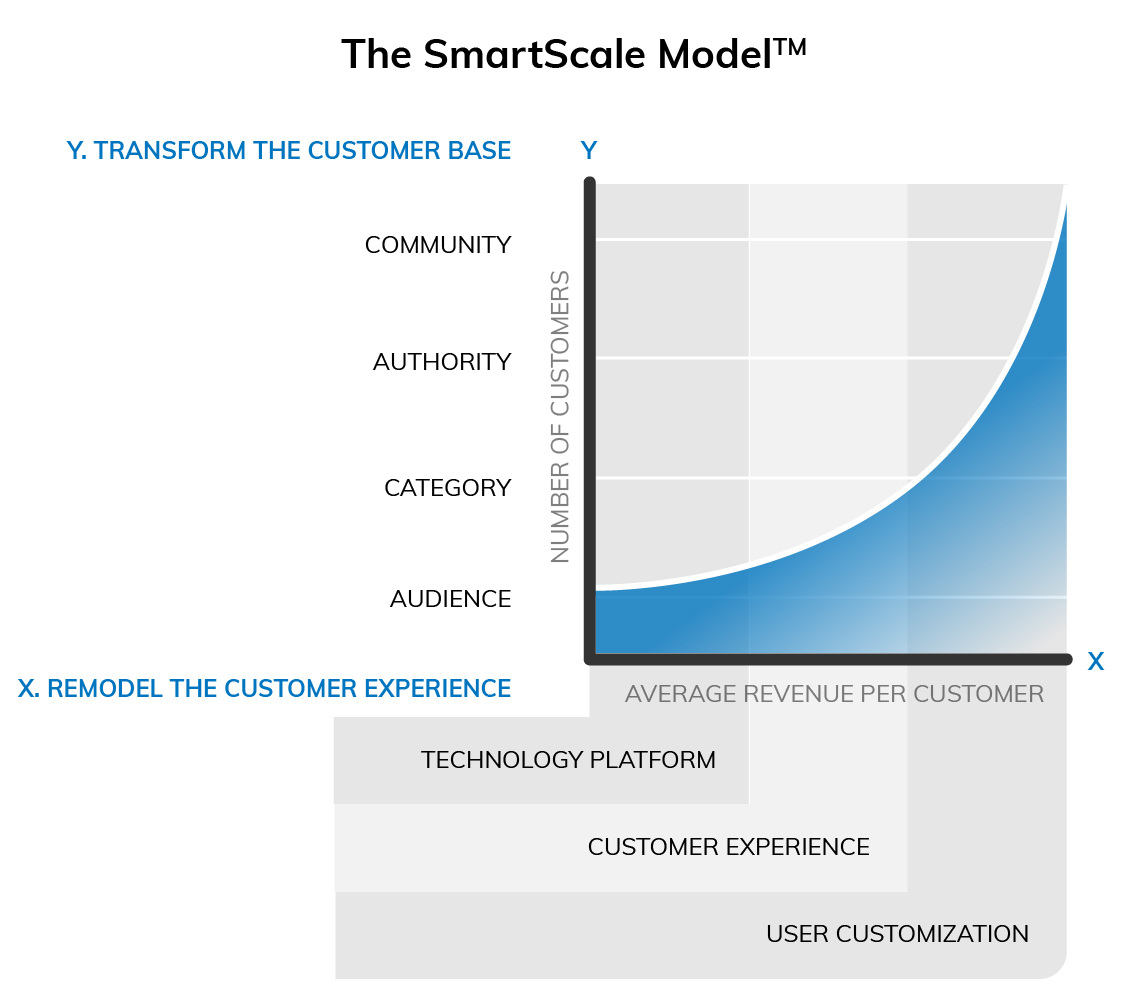
Mark Jacobs
CEO
Mark B. Jacobs has spent 30 years in executive leadership successfully guiding major growth initiatives – many starting as turnaround efforts. He has led re-capitalizations, start-ups, and key organizational change agendas that have scaled company growth and performance. He co-authored the SmartScale process which is built on his years of hands-on experience and expertise in Lean Manufacturing, Quality Systems, Sales & Operations Planning, Category Design & Development, Leadership Development, and Technology-Driven transformations.
Growth and the value of types of growth
How to achieve the most valuable type of growth - enterprise value growth.
In the traditional (code word for "outdated") way of thinking, value is an EBITDA multiple adjusted by customer concentration risk and future capital required. But thinking on that has recently changed. Enterprise value today is more heavily weighted towards customer equity. In fact, 65% of enterprise value is locked up in your loyal customer base and the lifetime value of those customers, including profit margins, retention rates, and referrals.
Why has customer equity, expressed as customer lifetime value, taken such a prominent position in valuation calculation? Because a loyal, growing customer base supports a robust and sustainable return on invested capital. A high lifetime value customer base suggests that leadership has created an enterprise with a clear focus on three corporate dictums: a sustainable strategy that propels company growth and protects capital allocation.
Conventional thinking about Business Strategy
Middle market leadership is typically well-schooled in traditional thinking around business value creation. These conventional leaders think in terms of 4 primary types of growth: strategic, internal, organic, and partnership/acquisition/merger growth.
1. Organic
Organic growth includes new products. With more products or services, sales increase. However, organic growth often necessitates more physical space to build, package, distribute or serve customers. Because growth requires investment, conventional thinking suggests that organic growth, on its own, is not sustainable in the long term.
2. Strategic
Strategic growth has a long-term focus. It's a significant step up from the organic growth stage.
Ideally, the organic growth stage will have produced enough capital for a company to invest in a long-term growth strategy – and the human and physical resources needed to execute.
Examples of strategic growth strategies range from new products to marketing strategies targeting a new audience.
3. Internal
Internal growth utilizes available resources. It is the thinking and tactics used to stretch resources so that external funding can be avoided – or put off.
Internal growth includes implementing lean or executing business model changes for resource optimization. A well-executed internal growth strategy lays the foundation for efficient and effective business operations.
4. Partnership, Acquisition, or Merger
Partnership, merger, or acquisition is generally considered the riskiest growth strategy type and the strategy with the highest commonly perceived potential for reward.
This strategy can open entry into a new market, expand an existing customer base, expand production capabilities, help introduce new products more smoothly, or accelerate innovation efforts.
According to Harvard Business Review between 70% and 90% of mergers and acquisitions fail. It’s a shocking number, and the one thing all have in common is people. Mergers and acquisitions fail more often than not because key people leave, teams don’t get along or demotivation sets into the company being acquired.
These strategies have their roots in the pre-large dataset analysis days. They encouraged competing and competitive advantage – usually promoting better, faster, cheaper approaches to innovation, service, product, and supply chain management. These strategies assumed that the company would earn a respectable portion of the existing "addressable" market – and centered customer research around how to "attract" customers. (Heavy on the marketing, branding, and comparison to competitors.)
And these growth strategies work. But they don't deliver the most valuable growth. That's because they don't focus on creating, developing, and growing the enterprise's most valuable asset: Customer Equity.
Category with a focus on achieving Scale is the new strategy
Category is not the new strategy – it's the old one that only a few companies could pull off. Category to deliver Scale – that's the new strategy. And it is a repeatable strategy given today's research, data analytics, and organizational development resources and technologies. There's even a tested, proven, reliable protocol that repeatedly delivers success.
The problem for most companies – and these tend to be the ones stuck in conventional thinking about growth, is that they don't have deep enough insight into their prospect and customer base (what we refer to as "the audience") to guide their business strategy. In fact, the insight that they do have may be biased (or just plain wrong) – driving tactics that debilitate the company's ability to be successful.
A simple example of this: We worked with a company that made plastic products for the finishing industry. Customer satisfaction/net promoter score (as opposed to customer loyalty) research kept delivering high marks…around the dimensions measured, such as price and service. Salespeople used scripts to interview clients and prospects. The information gathered pointed to customer interest in receiving more features on existing products, a lower price point, and easier access to online ordering and order tracking information. Product management took that information and continued to find ways to reduce costs and improve service features. Their reward for following the insight they'd gained? Customers shared the same aspirations with competitors – and "a race to the bottom" was triggered.
Category with a focus on achieving Scale uses a different approach – instead of surveying and researching customer satisfaction, it analyzes customer loyalty. It gives unbiased insight into how to provide the customer with a better version of themselves instead of a shallow, simple insight into the product or service.
The Process
Customer loyalty explores:
- Why a customer "hires" your company
- Gaps that the customer recognizes that they want to bridge (reasons to hire your company) and
- Uncovers gaps that the customer doesn't recognize – but when pointed out prompts the response, "you can do that? Wow! That would make perfect sense!"
Customer loyalty also measures the strength of the relationship between buyer and seller and between the organization and its customer.
The information gathered is analyzed to report customer loyalty at the time of the research and predict customer loyalty given a set of parameters to be achieved. The process of executing against this information (SmartScalingSM) delivers the scale curve in the ScaleWerks mode.
This process is so powerful that it can predict the future value of your customers – and your organization!
Do's and Don'ts
Loyalty research is a guidepost to corporate transformation. Transformations are hard work. Here's a few pointers we've picked up along the way:
- If your company manages people instead of processes (SmartScalingSM companies manage processes and lead people) – you're in for a cultural and business process transformation. Don't skip the culture part.
- This is about owning a category, not winning the "niche wars". If you are looking to be faster, better, and or cheaper – there are programs for that. This is a process approach that will make you different – and being different is a category strategy.
- According to studies by strategy firms only 8.0% of companies that undertake strategy initiatives achieve measurable results. This is not a strategy initiative – this is a full-on process – so be sure whoever you work with is in the execution business!

Outcome – if you do this right
Companies with clear Category Leadership, high Customer Equity, and following a strategy to capitalize on the predictable growth generated by a well-executed customer lifetime value (aka customer loyalty) process achieve valuations 5-10 times higher than companies that are following conventional strategies. Why don't more companies pursue a Category with a focus on Scale? In our experience it's one or more of these reasons:
- Leadership is outdated
- Leadership is out of touch
- Leaderships focus is wrong – usually on preserving satisfactory incremental gains and political position
Next Steps
Are you ready to make a real change to transform your business from a growing enterprise to one that scales? Learn more about the SmartScale℠ process or contact us to learn how we can help.